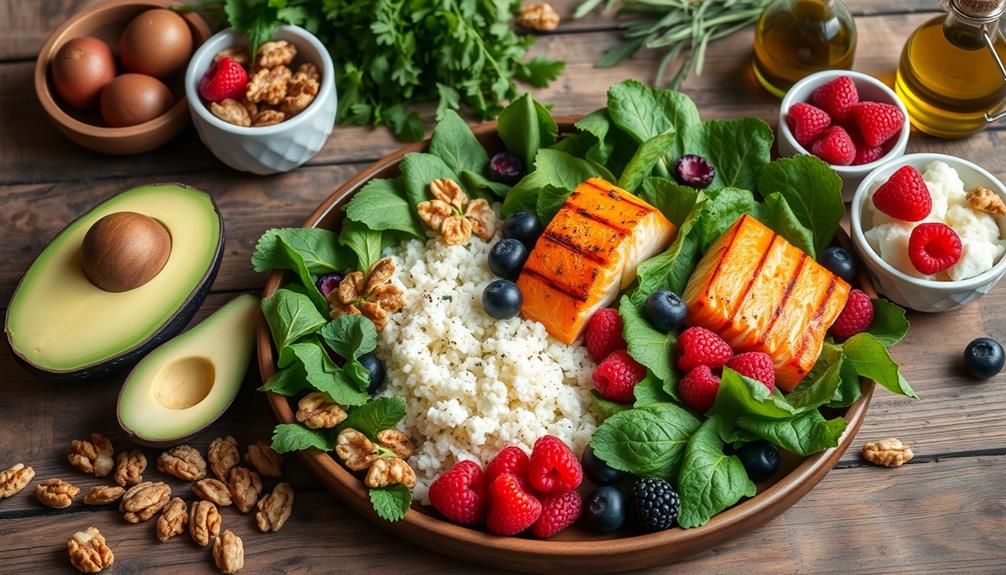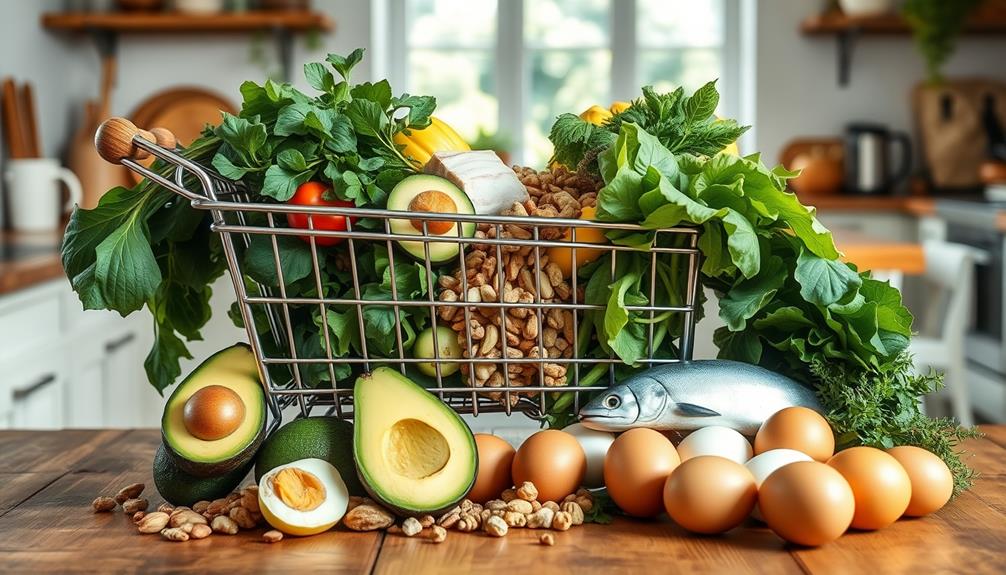On the keto diet, you can enjoy a variety of foods that keep your carbs low while boosting your healthy fats. Think meats, poultry, and seafood like salmon and shrimp. Eggs are a fantastic source of protein and have almost no carbs. Don't forget about low-carb veggies like spinach and zucchini, along with high-fat fruits such as avocados. Nuts and seeds make for great snacks too. For hydration, stick with water, bone broth, or unsweetened beverages. If you're curious about how to incorporate these foods into your meals, there's plenty more to explore!
Key Takeaways
- Focus on high-quality animal proteins, such as meat, poultry, seafood, and eggs, which are low in carbs and rich in nutrients.
- Incorporate healthy fats like olive oil, coconut oil, and ghee to enhance flavor and support ketosis.
- Consume non-starchy vegetables, such as spinach, zucchini, and leafy greens, which are low in carbs and high in fiber.
- Snack on low-carb options like nuts, cheese, jerky, and hard-boiled eggs for a satisfying protein boost.
- Stay hydrated with zero-carb beverages like water, bone broth, and unsweetened tea or coffee.
Overview of the Keto Diet
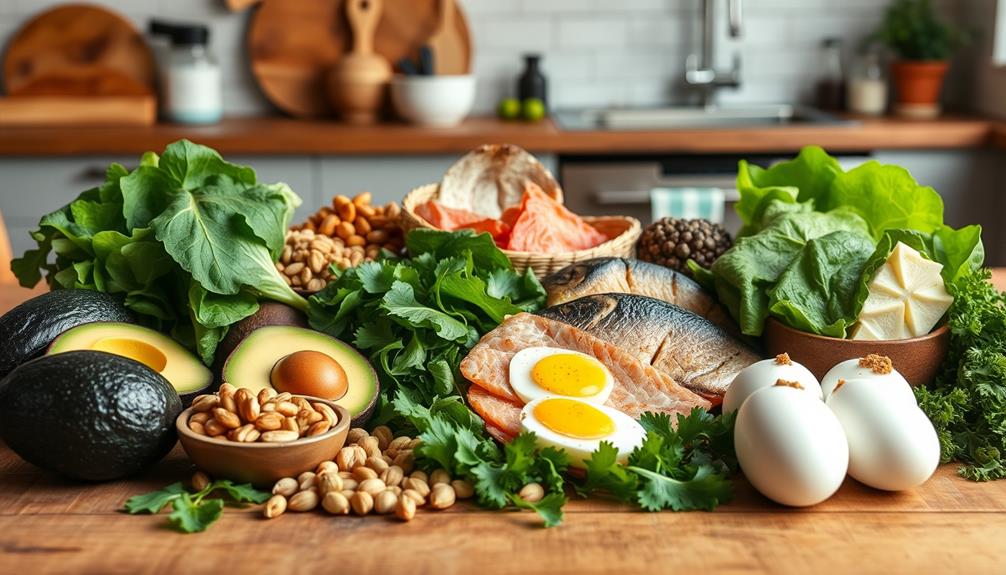
The ketogenic diet, often referred to simply as keto, focuses on drastically reducing carbohydrate intake while increasing fats, leading your body into a state of ketosis.
This unique metabolic state allows your body to burn fat for fuel instead of relying on carbohydrates. On the keto diet, you typically consume about 70-80% of your calories from healthy fats, 10-20% from proteins, and only 5-10% from carbohydrates.
This means your daily carb intake usually ranges from 20 to 50 grams, considerably limiting foods high in sugars and starches.
Additionally, incorporating nutrient-dense foods, such as leafy greens and high-fiber vegetables, can support overall health and digestion while adhering to the diet beneficial for overall health.
Animal Proteins

When you're on a keto diet, animal proteins become your go-to sources for high-quality protein without the carbs. Foods like meat, poultry, seafood, and eggs not only help preserve muscle health but also keep you feeling full longer.
Including these proteins in your meals can aid in managing hunger and cravings, similar to how gout-friendly diets emphasize the importance of protein sources.
Incorporating these proteins into your meals can support your shift into ketosis, making your keto journey more effective.
Protein Sources Overview
Protein plays an essential role in maintaining muscle mass, especially on low-carb diets like the keto diet. Animal proteins are excellent choices because they're high in protein and low in carbohydrates, making them ideal for your keto lifestyle.
In addition to protein, certain essential oils, such as peppermint oil for nausea relief, can enhance your overall well-being while following a keto diet.
Here are some great animal protein sources to take into account:
- Seafood: Fatty fish like salmon are nearly carb-free and packed with B vitamins. Aim for 8-10 ounces per week for added brain health benefits.
- Fresh Meat and Poultry: These options contain zero carbs and are high-quality protein sources. Choosing grass-fed meat offers extra omega-3s and conjugated linoleic acid (CLA).
- Eggs: With less than 1 gram of carbs per large egg, they're nutrient-dense and versatile. Plus, the cholesterol in yolks doesn't raise heart disease risk.
Dairy products, like cheese and Greek yogurt, also fit well into your keto plan. They're often low in carbs and high in fat, helping you feel full while providing essential nutrients like calcium.
Embrace these protein-rich foods to support your muscle maintenance on the keto diet!
Benefits for Muscle Health
Animal proteins are powerhouses for muscle health, especially on a keto diet. When you focus on high-quality animal sources like seafood, meat, poultry, and eggs, you're boosting your protein intake, which is fundamental for preserving muscle mass on a low-carb plan.
Additionally, choosing energy-efficient appliances can help streamline your cooking process, allowing for more time to focus on meal prep. Fresh meat and poultry are carb-free and packed with protein, helping keep you full while supporting your muscles.
Fatty fish, such as salmon, offer a double benefit; they provide high protein and necessary omega-3 fatty acids that can enhance muscle health and recovery. Eggs stand out, too—they contain less than 1 gram of carbs each while being nutrient-dense and an excellent protein source for muscle maintenance.
Including these animal proteins in your keto diet not only helps you build and maintain muscle but also aids in increasing HDL cholesterol levels. This is significant because higher HDL levels can support your overall cardiovascular health, which is crucial for any fitness regimen.
Seafood Options
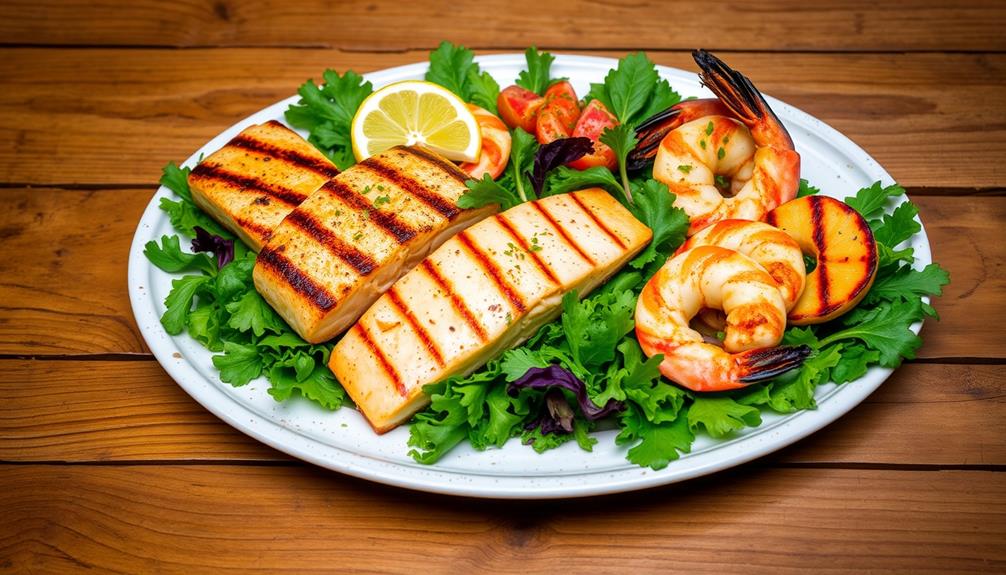
When you're following a keto diet, seafood options can be a fantastic addition to your meals. Not only are they low in carbs, but they also pack a punch with essential nutrients and healthy fats.
Incorporating seafood into your diet can also support overall health, as seen in strategies for lifestyle longevity.
Let's explore the different types of seafood you can enjoy and how much you should aim to eat each week for maximum benefits.
Nutritional Benefits of Seafood
Seafood lovers can rejoice, as this culinary treasure trove offers numerous nutritional benefits, especially for those adhering to a keto diet. Seafood is nearly carb-free, making it an excellent choice for keeping your carb intake low while still enjoying delicious meals.
It's also rich in essential B vitamins, which are essential for energy production and overall health. Additionally, seafood can be a valuable part of your investment strategy, as precious metal investments provide a stable financial foundation that complements a healthy lifestyle.
When you choose seafood, consider these benefits:
- Heart Health: Fatty fish like salmon are high in omega-3 fatty acids, which support heart function and may reduce inflammation.
- High-Quality Protein: Seafood is a fantastic source of protein that promotes satiety, helping you feel fuller longer and aiding in muscle preservation during low-carb diets.
- Brain Boost: Regular seafood intake (8-10 ounces per week) can improve brain health and lower the risk of disease.
While shellfish can be low in carbs, it's important to track your intake, as some options like shrimp and crab may vary.
Types of Seafood Choices
A variety of seafood choices can enhance your keto diet, offering both flavor and nutrition. Seafood is almost carb-free, making it an ideal option to keep your carbohydrate intake low. For instance, salmon packs 0 g of carbs, 4 g of fat, and 17 g of protein per 3 oz serving, making it a powerhouse of nutrients.
Fatty fish like salmon and mackerel are especially beneficial due to their high omega-3 fatty acid content, which supports heart health and may help reduce inflammation. Additionally, incorporating seafood into your meals can be a great way to support your overall financial health by opting for nutrient-dense foods that keep you fuller longer, helping to manage grocery expenses effectively common financial terms and jargon.
Don't overlook shellfish like shrimp and crab; they're also low in carbs, but be mindful of their intake since some varieties can be slightly higher in carbohydrates. Canned options like sardines and tuna provide convenience without sacrificing nutrition, delivering high-quality protein and healthy fats that fit perfectly into your keto meals.
To enjoy the benefits of seafood, aim for 8-10 ounces per week. This not only aligns with your keto goals but also contributes to improved brain health and a lowered risk of chronic diseases.
Embrace these seafood choices for a tasty and heart-healthy addition to your diet!
Recommended Weekly Intake
To maximize the benefits of seafood in your keto diet, aim for a recommended intake of 8-10 ounces each week. This will help you enjoy the high protein and essential nutrients seafood offers, while keeping your carb intake low.
Prioritize fatty fish like salmon, which is nearly carb-free and packed with omega-3 fatty acids that promote heart and brain health. Individuals with certain mental health disorders, such as BPD, may benefit from a balanced diet rich in omega-3s, as these nutrients can support emotional regulation.
To diversify your seafood choices, consider including:
- Fatty fish: Salmon, mackerel, and sardines are excellent sources of omega-3s and high protein.
- Shellfish: Shrimp, crab, and mussels can be enjoyed in moderation; just keep an eye on their varying carb content.
- Other options: Tuna, trout, and anchovies also provide essential nutrients and help prevent dietary monotony.
Eggs and Dairy
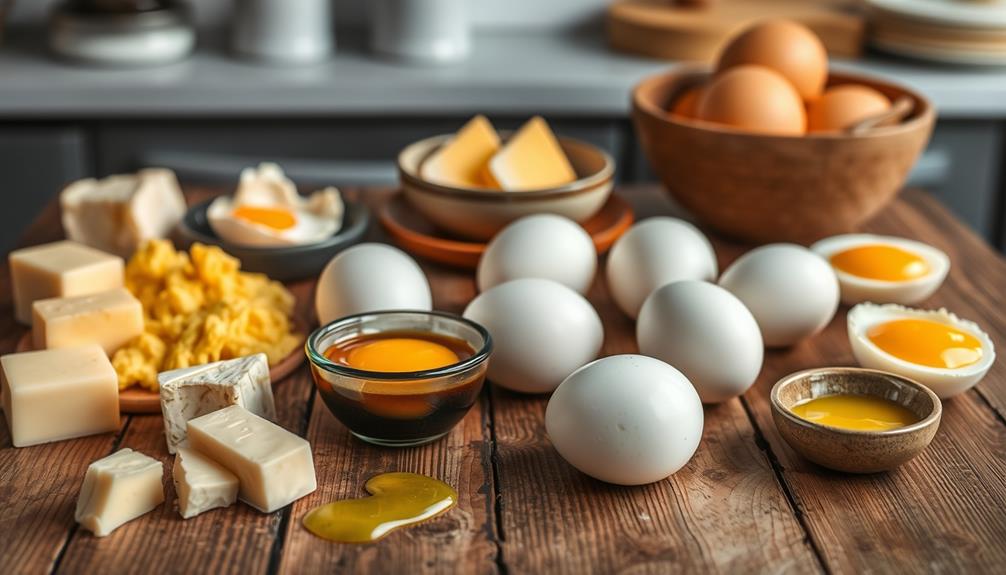
Eggs and dairy are two powerhouse foods that fit perfectly into the keto diet. When you include eggs in your meals, you're getting less than 1 gram of carbs per large egg. This makes them an excellent source of protein that promotes feelings of fullness.
Plus, the yolk is nutrient-dense, packed with essential vitamins, minerals, and antioxidants, without raising your heart disease risk despite its cholesterol content. Additionally, many coffee lovers enjoy incorporating eggs into their breakfast routine, complementing their morning brew for an enhanced experience with various brewing methods.
Dairy products also shine on the ketogenic diet, particularly cheese and full-fat Greek yogurt. Cheese typically contains around 1 gram of carbs per ounce, making it a great choice for your low-carb lifestyle.
You can also enjoy high-fat dairy options like cream and half-and-half as milk alternatives in your favorite keto recipes. Regularly incorporating these dairy products, especially cheese, may help preserve muscle mass and enhance overall satiety.
Healthy Fats and Oils
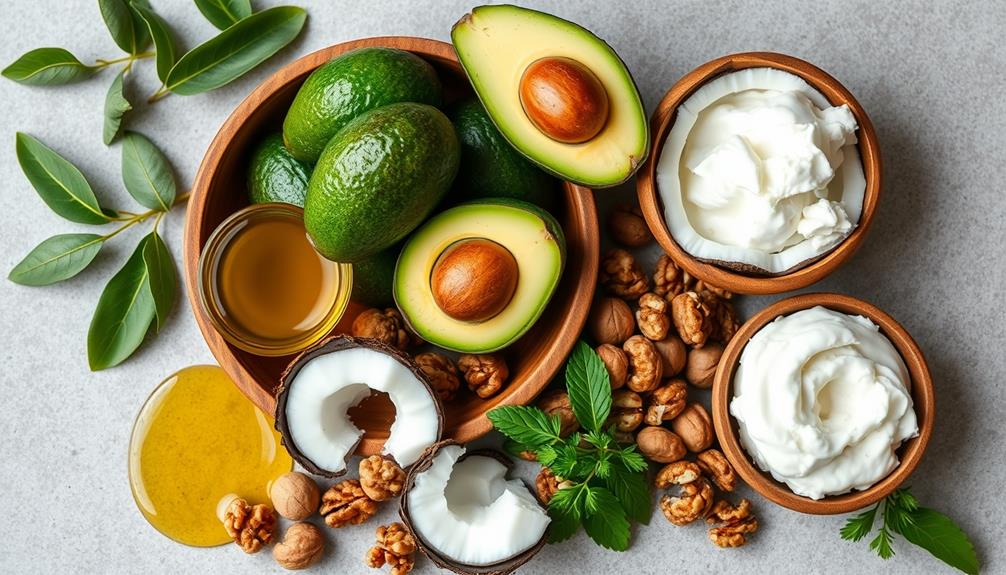
Healthy fats and oils are essential components of the keto diet, fueling your body and supporting important functions. By incorporating these healthy fats into your meals, you'll not only enhance flavor but also promote satiety, helping you control your appetite.
Celebrating heartfelt memories while nourishing your body can create a fulfilling experience. Here are some top choices for healthy fats:
- Olive oil: Rich in oleic acid and antioxidants, it's a heart-healthy option with anti-inflammatory properties.
- Coconut oil: Packed with medium-chain triglycerides (MCTs), it provides quick energy and supports weight loss and ketosis.
- Ghee: This clarified butter is lactose-free, has a concentrated flavor, and is perfect for high-temperature cooking.
Adding these fats to your diet can make a significant difference in your overall health and adherence to the ketogenic lifestyle. They not only provide essential energy but also support hormone production.
Non-Starchy Vegetables

When you're following a keto diet, non-starchy vegetables are your best friends. They pack a punch in nutrients while keeping carbs low, with options like cauliflower, zucchini, and leafy greens adding variety to your meals.
Let's explore how you can incorporate these veggies into your meal prep for maximum benefits.
Nutrient Density Benefits
Non-starchy vegetables play an essential role in maximizing nutrient density on a keto diet. These veggies, like spinach, kale, and zucchini, are incredibly low in carbs and packed with essential vitamins, minerals, and antioxidants.
Because they contribute fewer than 5 grams of net carbs per serving, you can enjoy generous portions without worrying about surpassing your daily carb limits.
Here are some nutrient density benefits of non-starchy vegetables:
- Rich in Vitamins: Dark leafy greens provide important nutrients, such as vitamin K, critical for bone health and blood clotting.
- High in Fiber: These vegetables are excellent sources of fiber, promoting digestive health and helping you feel full longer.
- Color and Flavor: Incorporating a variety of non-starchy vegetables adds vibrant colors and flavors to your meals, making it easier to meet your daily nutrient needs.
Low-Carb Vegetable Options
Incorporating low-carb vegetable options into your keto diet can greatly enhance your meals while keeping your carb intake in check. Non-starchy vegetables, such as cauliflower, broccoli, spinach, zucchini, and bell peppers, are excellent choices, typically containing just 3-7 grams of net carbs per 3.5 ounces.
Leafy greens like kale and Swiss chard are particularly nutrient-dense, offering essential vitamins and minerals without adding significant carbs.
Asparagus and green beans are also versatile low-carb options, with about 4 grams of net carbs per 3.5 ounces, making them suitable for various keto recipes.
Don't forget avocados! Although they're technically a fruit, they fit perfectly into savory dishes. With only 2 grams of net carbs per 3.5 ounces, avocados are rich in healthy fats and fiber.
Meal Preparation Ideas
For a successful keto meal prep, think about how you can creatively use non-starchy vegetables to add flavor and nutrition.
These veggies are low in carbohydrates and packed with essential vitamins and minerals, making them perfect for your ketogenic diet.
Here are some meal preparation ideas to get you started:
- Spiralized Zucchini: Use this as a pasta substitute. Toss it with your favorite keto-friendly sauce for a delicious, low-carb meal.
- Cauliflower Rice: Substitute traditional grains with cauliflower rice. It's a versatile base for stir-fries, curries, or as a side dish.
- Sautéed Greens: Incorporate dark leafy greens like kale and spinach into your meals. Sauté them in olive oil or coconut oil for added flavor and healthy fats.
High-Fat Fruits

When it comes to the keto diet, high-fat fruits like avocados and olives are essential for maintaining your fat intake while keeping carbohydrates low. These fruits not only provide healthy fats but also enhance your meals with flavor and nutrition.
Here's a quick overview of some high-fat fruits you can enjoy on the keto diet:
| Fruit | Healthy Fats (g) | Net Carbs (g) |
|---|---|---|
| Avocado | 15 | 2 |
| Olives | 11-15 | 3-6 |
| Coconut | 33 | 6 |
| Blackberries | 0.5 | 5 |
| Raspberries | 0.5 | 7 |
Including avocados in your salads or using olives as a snack can greatly boost your healthy fats. Coconuts are versatile, perfect for smoothies or baking. While blackberries and raspberries are lower in fat, they still fit well into your keto diet by providing fiber and antioxidants. Embrace these high-fat fruits to stay in ketosis and enjoy delicious, satisfying meals!
Nuts and Seeds
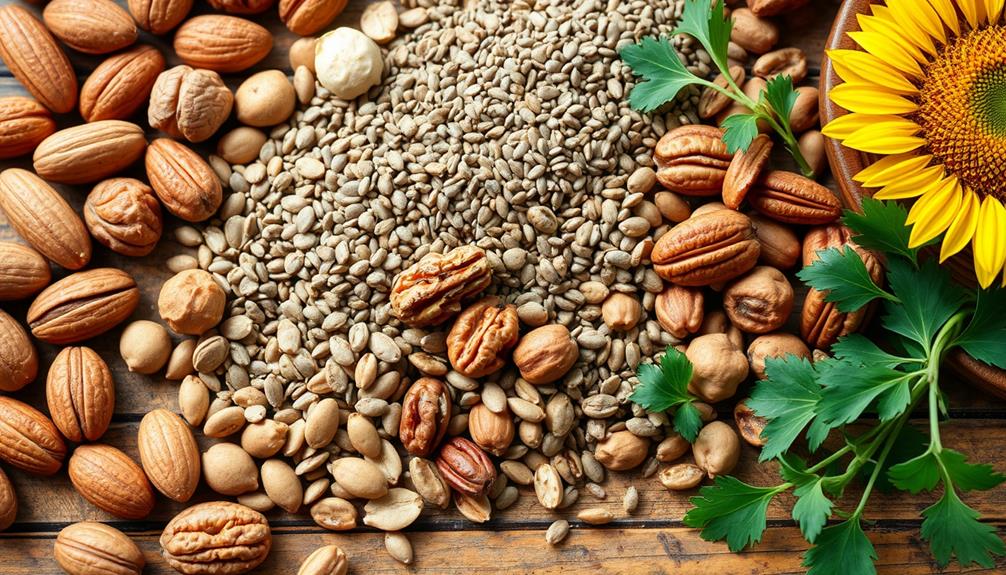
Nuts and seeds play an essential role in the keto diet, offering a delicious way to increase your intake of healthy fats while keeping carbs to a minimum.
These power-packed foods are high in healthy fats, fiber, and protein, making them perfect for your low-carb lifestyle.
Here are some fantastic options to include in your diet:
- Almonds: About 2.5 grams of net carbs per ounce, with 14 grams of fat and 6 grams of protein.
- Walnuts: Only 2 grams of net carbs per ounce, rich in omega-3 fatty acids for heart health.
- Chia and Flaxseeds: Approximately 1 gram of net carbs per ounce, high in fiber, and great for digestive health.
Incorporating these nuts and seeds into your meals not only helps keep your carbohydrate intake low but also provides essential vitamins, minerals, and antioxidants.
Regular consumption has even been linked to a reduced risk of chronic diseases.
Low-Carb Snacks
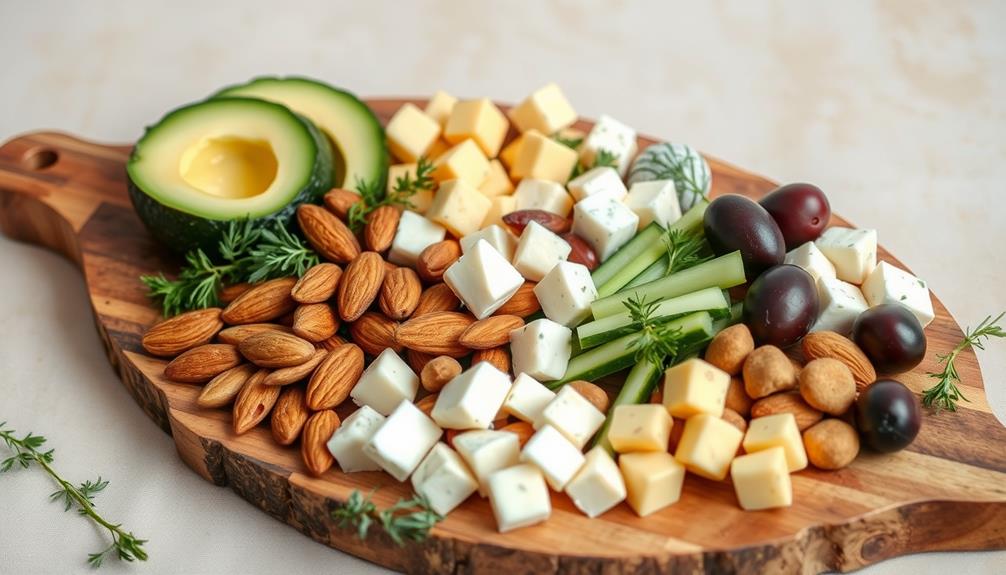
Maintaining a low-carb lifestyle doesn't mean sacrificing snacks that satisfy your cravings. You can enjoy a variety of low-carb snacks that are both delicious and nutritious.
For instance, nuts and seeds like almonds and walnuts are packed with healthy fats and high-quality protein while remaining low in carbs. Just one ounce of almonds contains about 6 grams of carbs and 3.5 grams of fiber, making them a great choice.
Cheese is another fantastic option; varieties like cheddar or mozzarella offer around 1 gram of carbs per ounce, along with satisfying protein and fat.
Hard-boiled eggs are also convenient snacks, providing less than 1 gram of carbs and a wealth of essential nutrients.
If you're in the mood for something crunchy, try vegetable sticks such as cucumber or celery paired with high-fat dips like guacamole or cream cheese.
Finally, don't overlook sugar-free beef jerky, which typically has 1 gram of carbs or less per serving, ensuring a protein-rich snack that keeps you in ketosis.
With these options, you can indulge in tasty low-carb snacks without compromising your diet.
Beverages to Consider
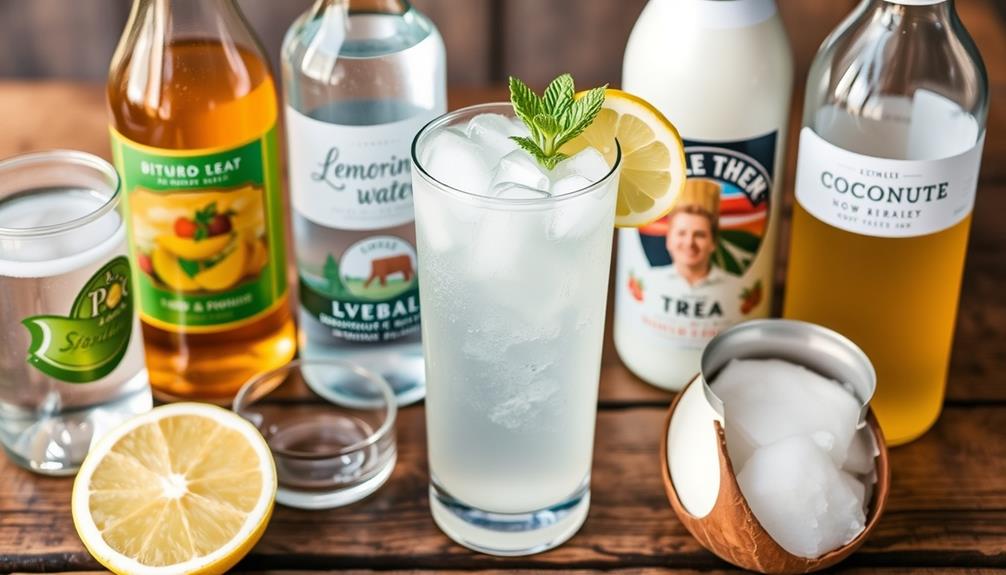
Staying hydrated is essential on a keto diet, and fortunately, there are plenty of delicious beverage options that keep your carb count in check. Here are some great choices to evaluate:
- Water: The ultimate zero-carb beverage, perfect for daily hydration.
- Bone Broth: Rich in nutrients and electrolytes, it's a warming option that supports your keto lifestyle.
- Sparkling Water: A bubbly alternative to sugary drinks that adds excitement without the carbohydrates.
Additionally, unsweetened coffee and tea are fantastic options, offering health benefits like improved metabolism and longevity.
Herbal teas can also be a great way to relax and aid digestion, all while keeping your beverage choices carb-free.
Frequently Asked Questions
What Food Is Not Allowed in Keto?
On the keto diet, you should avoid high-carb foods like bread, pasta, rice, sugary snacks, starchy vegetables, and certain fruits. These can hinder your ketosis, making it harder to achieve your health goals.
What Fruits Can You Eat on a Keto Diet?
You can enjoy low-carb fruits like strawberries, blackberries, and raspberries in moderation. Avocados, olives, lemons, and limes are also great options for adding flavor and healthy fats without spiking your carb intake.
What Are the 9 Rules of Keto?
When you're following keto, remember these nine rules: limit carbs, increase fats, choose quality proteins, focus on non-starchy veggies, stay hydrated, track your intake, avoid processed foods, prioritize whole foods, and listen to your body.
What Foods Do You Cut Out on the Keto Diet?
When you commence the keto journey, think of it as clearing a garden: uproot high-carb foods like bread and sugar-laden treats, tossing them aside to let low-carb delights flourish and thrive in your plate.
Conclusion
Embracing the keto diet can transform your eating habits and boost your health. For instance, imagine Sarah, who struggled with her weight for years. After switching to keto, she found joy in foods like salmon and avocados while shedding 30 pounds in just a few months. By focusing on nutrient-dense, low-carb options, you too can achieve your wellness goals. Remember, it's not just about what you eat; it's about creating a lifestyle that supports your health journey.
